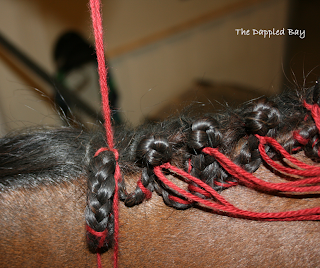Bran is a very useful addition to the diet of hard keepers, geriatric horses, and those that are recovering from malnutrition. Both rice and wheat bran are highly palatable to horses and can be used to encourage picky eaters to clean up their grain, especially if it contains medications or supplements. The process of soaking bran mashes, especially those made from wheat bran, can also increase their palatability for horses with chewing problems, as well as their water intake.
Performance horses can benefit from bran as a dense source of calories, capable providing the energy required for many physically demanding disciplines without the increased sugars and starches found in many grains. Rice bran is particularly valuable in this respect, boasting fat at a whopping 20% in addition to its high fiber content. Its high fat content can be broken down and metabolized by a horse's system more easily than most grains, providing an easily accessed energy source.
The Risks of Feeding Bran
Unfortunately, scientists and veterinarians have shown that feeding horses a bran mash does not actually deliver the digestive benefits that horsemen had come to expect. In fact, feeding excessive amounts of bran can actually increase a horse's risk of developing intestinal stones called enteroliths, a common cause of colic.
Additionally, feeding too much bran can cause an imbalance in the horse's calcium-phosphorus ratio (Ca:P) due to the fact that both wheat and rice bran have nearly 10 times more phosphorus than calcium. When the amount of phosphorus in the diet exceeds the amount of calcium for an extended period of time, the horse's body will begin to pull calcium from the bones to make up for the imbalance. The resulting disease, nutritional secondary hyperparathyroidism, is marked by a weakening of the horse's skeletal structure, shifting lameness and, in young horses and severe cases, an enlargement of the skull that gives the disease its nickname, "bighead disease."
Determining the Calcium-Phosphorus Ratio of Your Horse's Diet
The trick to determining your horse's Ca:P is knowing what the correct ratio should be and comparing your horse's diet to that standard. Veterinarians and equine nutritionists mark the ideal Ca:P as anywhere between 1.2:1 and 2:1. Some studies have even shown that a horse's Ca:P can be as high as 6:1 without any adverse effects.
Although you can - and should - have your veterinarian periodically draw your horse's blood to determine whether it has any nutritional deficiencies, knowing the nutritional values of many commonly fed hays and grains is also an important part of creating a balanced diet:
- Most factory-produced grains and pelleted feeds are specially fortified to ensure a balanced Ca:P and come with a guaranteed nutritional analysis.
- Rolled oats, which are commonly fed to HYPP horses requiring a diet that is low in potassium, and other plain grains such as corn contain substantially more phosphorus than calcium.
- Some commonly fed grass hays - timothy, orchard grass, Kentucky bluegrass, and fescue, among others - contain exactly the right Ca:P for horses.
- Other hays - alfalfa (lucerne), Midwest prairie grass, and clover - have a significantly higher Ca:P that is nearer to 6:1.
- Beet pulp, frequently used to preserve the condition of older horses or put weight on hard keepers, has a significantly higher amount of calcium than phosphorus, averaging 1.09% Ca to 0.07% P.
Adding together the individual Ca:P of all the foodstuffs that you feed to your horse, including any multivitamin supplements, will give you a fair picture of your horse's diet and help you determine whether you need to make any changes.
Feeding a Balanced Bran Mash
Today, some grain manufacturers have introduced Ca:P balanced, stabilized rice bran products into the market as a supplement for older horses, hard keepers, and performance horses that need additional energy. These supplements are safe to feed as-is and do not require any additional calcium supplementation. However, they can be costly and difficult to find in some areas.
If feeding a Ca:P balanced rice bran is too cost prohibitive or there are none to be found in your area, you can create your own Ca:P balanced bran mash:
- One part bran (rice or wheat)
- One part beet pulp or alfalfa (your choice)
- Hot water, added until the mixture takes on an oatmeal consistency
Of course, you can "dress up" the mash by adding in your horse's favorite treats. My horse, Sam, is particularly fond of the tried-and-true combination of soft peppermints and molasses in his bran.






























